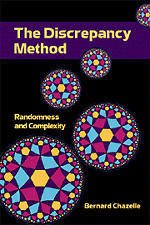Description
The Discrepancy Method
Randomness and Complexity
Author: Chazelle Bernard
Explores the link between discrepancy theory and randomized algorithms.
Language: English
Subject for The Discrepancy Method:
Approximative price 143.25 €
Subject to availability at the publisher.
Add to cart
The discrepancy method. Randomness and complexity
Publication date: 07-2000
494 p. · 15.2x22.9 cm · Hardback
Publication date: 07-2000
494 p. · 15.2x22.9 cm · Hardback
Approximative price 63.72 €
Subject to availability at the publisher.
Add to cart
The Discrepancy Method : Randomness and Complexity, paperback
Publication date: 01-2002
494 p. · 15.2x22.9 cm · Paperback
Publication date: 01-2002
494 p. · 15.2x22.9 cm · Paperback
Description
/li>Contents
/li>
The discrepancy method is the glue that binds randomness and complexity. It is the bridge between randomized computation and discrepancy theory, the area of mathematics concerned with irregularities in distributions. The discrepancy method has played a major role in complexity theory; in particular, it has caused a mini-revolution of sorts in computational geometry. This book tells the story of the discrepancy method in a few short independent vignettes. It is a varied tale which includes such topics as communication complexity, pseudo-randomness, rapidly mixing Markov chains, points on the sphere and modular forms, derandomization, convex hulls, Voronoi diagrams, linear programming and extensions, geometric sampling, VC-dimension theory, minimum spanning trees, linear circuit complexity, and multidimensional searching. The mathematical treatment is thorough and self-contained. In particular, background material in discrepancy theory is supplied as needed. Thus the book should appeal to students and researchers in computer science, operations research, pure and applied mathematics, and engineering.
1. Combinatorial discrepancy; 2. Upper bounds in geometric discrepancy; 3. Lower bounds in geometric discrepancy; 4. Sampling; 5. Geometric searching; 6. Complexity lower bounds; 7. Convex hulls and Voronoi diagrams; 8. Linear programming and extensions; 9. Pseudo-randomness; 10. Communication complexity; 11. Minimum spanning trees; A. Probability theory; B. Harmonic analysis; C. Convex geometry.
© 2024 LAVOISIER S.A.S.

